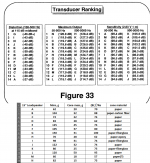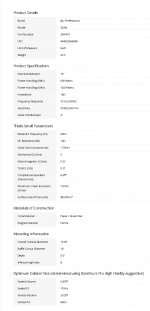Or as my friend Roger used to say back in college:
"I was wrong and You were right; I shall die and You shall live forever"
"I was wrong and You were right; I shall die and You shall live forever"
..They are possibly using it more like a midbass module by crossing around 200Hz to cancel floor reflections...
Oh so thats the trick....
When I first looked at the graph below I was mad that there was no connection to alphabetic order and other aspect of mass or motor listed by the character
My interpretation; At face value these charts serve to say that there is no obvious connection to mass/motor and superior performance of "distortion" (what ever one they are referring to) sensitivity and max spl.
Attachments
Last edited:
When I first looked at the graph below I was mad that there was no connection to alphabetic order and other aspect of mass or motor listed by the character
My interpretation; At face value these charts serve to say that there is no obvious connection to mass/motor and superior performance of "distortion" (what ever one they are referring to) sensitivity and max spl.
Look at A lowest mass lower performance distortion wise highest sensitivity. That's a hint look at higher mass like G and look at the ratings.
You really need to look at the entire paper. The conclusion is opposing requirements that need to be juggled by the designer for the desired overall response.
Rob🙂
The driver models are not indicated, but from the description of the drivers it can be understood that G and I are JBL (G is with Aquaplast coating), the J driver is TAD 1601 (the only driver with Alnico magnets), the N driver is with a neodymium magnet and a heatsink (I think at that time, very few such drivers were produced, and if you look for 15 "drivers of those years with Nd magnets, you can determine the manufacturer.) The description indicates that some of the drivers are guitar.
P.S.
Probably N is also JBL
History | JBL Professional Loudspeakers
Probably N is also JBL
History | JBL Professional Loudspeakers
...
1991 – The first pro-audio speaker using a neodymium magnet in Array Series
...
Yes, much smaller woofer for me. 1" waveguide loaded dome, 6.5" midwoofer, with 2 x 10" subs, which will probably end up crossed at 100Hz and 2.2khz. Its a compromise.
I consider that the most important benefit of 2 way horn (and full range) is it does not have a crossover around 2K. We can hear the difference if we compare them (with crossover vs without) side by side. I would not call this a compromise, it is a very different direction.
1991 – The first pro-audio speaker using a neodymium magnet in Array Series
This one is 14", btw.
I consider that the most important benefit of 2 way horn (and full range) is it does not have a crossover around 2K. We can hear the difference if we compare them (with crossover vs without) side by side. I would not call this a compromise, it is a very different direction.
Well, we'll see where it ends up. bonus of active and the WG. with the drivers I have, I probably have the freedom to play with M->T XO anywhere from 1500->2500. just matter of where it lands.
by compromise, I dont mean a compromise between some ideal 2 way, starting from scratch buying drivers and enclosure with large WG. I mean it's a compromise in general, given my space and the fact I have some drivers already. next build will in all likelihood be a 2 way with pro drivers, but that's a ways off and i'm not entirely convinced I would prefer with no subs. space is too small for econowave types. XO is digital and I will do most listening fairly nearfield. aside from the DAC. i'm doing my best to use as many parts that I have already, which is many. I bought the parts years ago, just haven't had any workshop space for years and i'd rather not spend up big on drivers again just yet. Then I can play with quite different designs and drivers and take my time on the enclosure, iteratively fixing any problems identified and hopefully kitted out with reasonable CNC in the shed by then..
Last edited:
Thanks!! This one will be a learning experience. Hell, I may end up just replacing the revelators with something from purifi, like the new PTT6.5X04-NAA-08, maybe even an 8", when they release it, team it with some bliesma be domes and leave it at that. the 6.5 would drop right into the place of the revelators and maybe it could end there for a bit, but i'm intrigued to see what they can do with 8 and 10" models; provided they dont cost more than $500 each.
The latency of the APOs varies based on the signal processing within the APOs. ... In Windows 10, the latency has been reduced to 1.3ms for all applications. The Audio Engine writes the processed data to a buffer. Before Windows 10, this buffer was always set to ~10ms.Jun 16, 2021
In a lot of woofers I see, with an 8ohm and 16ohm design, the 16ohm design has half the Qts/Qes of the 8ohm version......whats the connection?
Measuring Loudspeaker Driver Parameters
The calculations for those parameters depend on Re
The calculations for those parameters depend on Re
Last edited:
yes but what about the times where a manufacturer has the same driver and both 8ohm vs 16ohm models are listed as matching Q specs....how is this achieved?
Yeah I believe that, I'm looking at the spec sheet for the 2226J vs 2226H and it only list one set of Q specs.
If I remember correctly....Q can be adjusted via slope of the roll off via EQ? If this is true.... then the only disadvantage I am left with regarding the AETD15m I have with Q=6 and Tm=17 Re=12.5 is the loss of sensitivity from the weak motor force.
Is this something I can have the manufacturer "fix"?
If I remember correctly....Q can be adjusted via slope of the roll off via EQ? If this is true.... then the only disadvantage I am left with regarding the AETD15m I have with Q=6 and Tm=17 Re=12.5 is the loss of sensitivity from the weak motor force.
Is this something I can have the manufacturer "fix"?
Since this is all custom, seems like you'd want a 16 ohm system to keep current draw/thermal power distortion low.
Anyone against the Jbl 2226J?
Attachments
Look at A lowest mass lower performance distortion wise highest sensitivity. That's a hint look at higher mass like G and look at the ratings.
You really need to look at the entire paper. The conclusion is opposing requirements that need to be juggled by the designer for the desired overall response.
Rob🙂
Yeah but Look at L, it breaks the trend.
Hi Camplo
Since you want to lower the Qts you can't just take a resistor out of your parts bin because you would need a negative resistor and those don't come in the usual form of a component with two leads. It has to be synthesized using current feedback from the amp's output. The active PSI studio monitors use something like that. Another method that gives the same response without using current feedback is the use of EQ. If the fc is correct and only the Qtc is wrong you can get the desired response with a parametric EQ. If both the fc and Qtc have to be corrected you can use a biquadratic filter like the Linkwitz transform for instance.
Charles
Does changing the roll off change Qes?
If these measurements are accurate
Changing Qes to .3 gives me correct BL. So can a filter cause that?...is what I am getting at?
Attachments
Last edited:
- Home
- Loudspeakers
- Multi-Way
- Is it possible to cover the whole spectrum, high SPL, low distortion with a 2-way?


